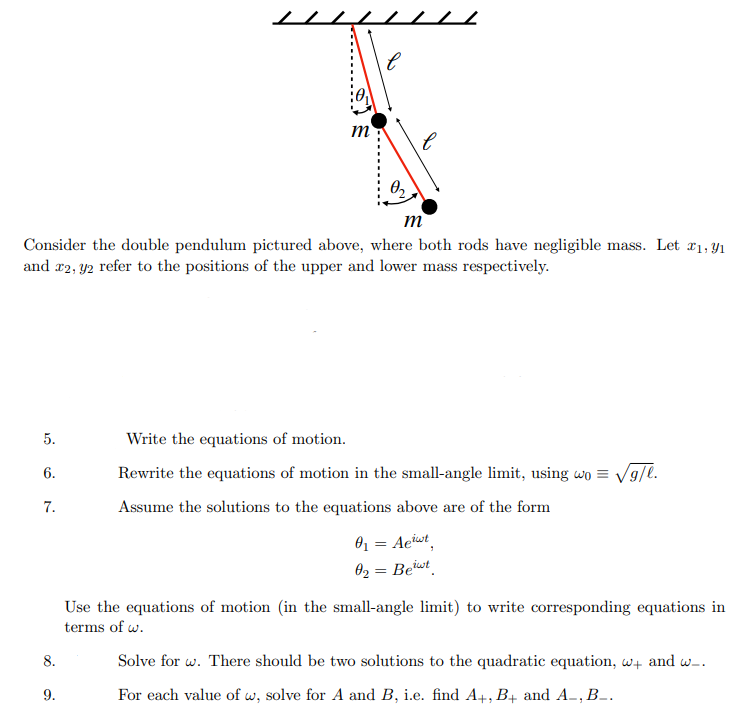Consider the double pendulum pictured above, where both rods have negligible mass. Let 21, 3₁ and 2, 32 refer to the positions of the upper and lower mass respectively. 5. 6. 7. 8. 9. Write the equations of motion. Rewrite the equations of motion in the small-angle limit, using wo = √g/l. Assume the solutions to the equations above are of the form 0₁ = Aelwt, Beit 0₂: = Use the equations of motion (in the small-angle limit) to write corresponding equations in terms of w. Solve for w. There should be two solutions to the quadratic equation, w+ and w. For each value of w, solve for A and B, i.e. find A+, B+ and A-, B_.
Consider the double pendulum pictured above, where both rods have negligible mass. Let 21, 3₁ and 2, 32 refer to the positions of the upper and lower mass respectively. 5. 6. 7. 8. 9. Write the equations of motion. Rewrite the equations of motion in the small-angle limit, using wo = √g/l. Assume the solutions to the equations above are of the form 0₁ = Aelwt, Beit 0₂: = Use the equations of motion (in the small-angle limit) to write corresponding equations in terms of w. Solve for w. There should be two solutions to the quadratic equation, w+ and w. For each value of w, solve for A and B, i.e. find A+, B+ and A-, B_.
Elements Of Electromagnetics
7th Edition
ISBN:9780190698614
Author:Sadiku, Matthew N. O.
Publisher:Sadiku, Matthew N. O.
ChapterMA: Math Assessment
Section: Chapter Questions
Problem 1.1MA
Related questions
Question
I need some help with this classical

Transcribed Image Text:5.
6.
7.
2
8.
9.
m
е
m
Consider the double pendulum pictured above, where both rods have negligible mass. Let 2₁,3₁
and 22,32 refer to the positions of the upper and lower mass respectively.
0₂
Write the equations of motion.
Rewrite the equations of motion in the small-angle limit, using wo = √√√g/l.
Assume the solutions to the equations above are of the form
0₁ = Aelwt
0₂= Beit
Use the equations of motion (in the small-angle limit) to write corresponding equations in
terms of w.
Solve for w. There should be two solutions to the quadratic equation, w+ and w_.
For each value of w, solve for A and B, i.e. find A+, B+ and A-, B_.
Expert Solution
This question has been solved!
Explore an expertly crafted, step-by-step solution for a thorough understanding of key concepts.
This is a popular solution!
Trending now
This is a popular solution!
Step by step
Solved in 6 steps with 8 images

Knowledge Booster
Learn more about
Need a deep-dive on the concept behind this application? Look no further. Learn more about this topic, mechanical-engineering and related others by exploring similar questions and additional content below.Recommended textbooks for you

Elements Of Electromagnetics
Mechanical Engineering
ISBN:
9780190698614
Author:
Sadiku, Matthew N. O.
Publisher:
Oxford University Press

Mechanics of Materials (10th Edition)
Mechanical Engineering
ISBN:
9780134319650
Author:
Russell C. Hibbeler
Publisher:
PEARSON

Thermodynamics: An Engineering Approach
Mechanical Engineering
ISBN:
9781259822674
Author:
Yunus A. Cengel Dr., Michael A. Boles
Publisher:
McGraw-Hill Education

Elements Of Electromagnetics
Mechanical Engineering
ISBN:
9780190698614
Author:
Sadiku, Matthew N. O.
Publisher:
Oxford University Press

Mechanics of Materials (10th Edition)
Mechanical Engineering
ISBN:
9780134319650
Author:
Russell C. Hibbeler
Publisher:
PEARSON

Thermodynamics: An Engineering Approach
Mechanical Engineering
ISBN:
9781259822674
Author:
Yunus A. Cengel Dr., Michael A. Boles
Publisher:
McGraw-Hill Education

Control Systems Engineering
Mechanical Engineering
ISBN:
9781118170519
Author:
Norman S. Nise
Publisher:
WILEY

Mechanics of Materials (MindTap Course List)
Mechanical Engineering
ISBN:
9781337093347
Author:
Barry J. Goodno, James M. Gere
Publisher:
Cengage Learning

Engineering Mechanics: Statics
Mechanical Engineering
ISBN:
9781118807330
Author:
James L. Meriam, L. G. Kraige, J. N. Bolton
Publisher:
WILEY